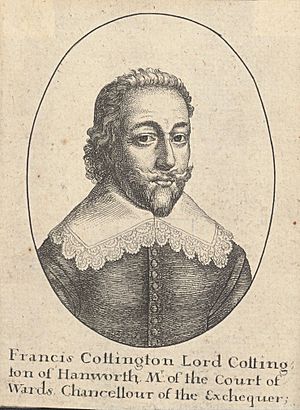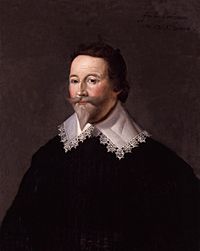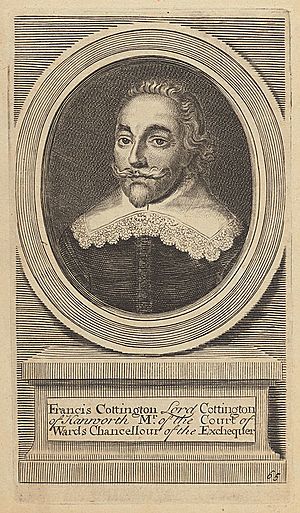Francis Cottington, 1st Baron Cottington facts for kids
Francis Cottington, 1st Baron Cottington (born around 1579, died 1652) was an important English politician. He served as a top financial officer (called the Lord Treasurer) and represented England as an ambassador to other countries. He was known for supporting Spain and the Roman Catholic faith in the court of King Charles I.
Contents
Early Life and Spanish Connections
Francis Cottington was born in Somerset, England. He was the fourth son in his family. Early in his career, he worked for Sir Charles Cornwallis, who was England's ambassador to Spain. This experience helped him learn a lot about Spanish culture and politics. From 1609 to 1611, he even acted as England's agent in Spain.
In 1612, he became the English consul in Seville, a city in Spain. His time in Spain made him very useful to King James I, who ruled England at the time. Cottington always had a strong liking for Spain. He even suggested that Prince Charles (who later became King Charles I) should marry a Spanish princess instead of a French one.
A Career in Royal Service
In 1616, Francis Cottington went back to Spain as an ambassador. He helped King James I try to settle a disagreement involving Frederick V, a German prince.

After returning to England, he became secretary to Prince Charles in 1622. He was also made a knight and a baronet in 1623. Cottington did not agree with Prince Charles's trip to Spain, as he thought it would ruin England's plans for marriage and alliances. However, he was told to go along anyway. His disagreement angered George Villiers, the Duke of Buckingham, who was very powerful. When Charles I became king, Buckingham had Cottington removed from his jobs and banned from the royal court. But after Buckingham was killed, Cottington was able to return.
Important Roles and Rivalries
Francis Cottington was a Roman Catholic at heart. He joined the Catholic Church in 1623, then returned to Protestantism, and then became Catholic again in 1636. He strongly supported Catholics in England. In 1628, he became a Privy Councillor, which meant he was a trusted advisor to the King. In 1629, he was made Chancellor of the Exchequer, a very important job in charge of the country's money.
Later that year, he went back to Spain as an ambassador. He signed a peace treaty with Spain in 1630. He also made a secret agreement to divide the Dutch Republic between Spain and England. In return, a region called the Palatinate would be given back. In 1631, he was given the title Baron Cottington of Hanworth.
In 1635, he became the Master of the Court of Wards and Liveries. This job allowed him to collect money, and his actions made the government very unpopular. He also worked with William Laud, who was a powerful archbishop. The two men became strong rivals. Cottington was often better at handling their arguments because he was calm and good at hiding his true feelings. Laud, however, was not as skilled in this.
Cottington wanted to become the Lord Treasurer, the highest financial position. But Laud managed to get his own choice, Bishop Juxon, appointed instead. After this, Cottington focused more on his own duties. Still, he remained involved in important government matters, especially those concerning foreign affairs and issues in Ireland and Scotland. He supported the war in Scotland. In 1640, he believed the King could raise money without Parliament's approval during a crisis. He tried to get funds from the City of London but failed.
He was also made the constable of the Tower of London and prepared it for a siege. In 1641, during the trial of Thomas Wentworth, the Earl of Strafford, Cottington swore under oath that he had not heard Strafford say certain damaging words. As the Parliament's power grew, Cottington, who was disliked by many in Parliament, decided to leave his government jobs. He gave up his role at the Court of Wards in 1641 and as Chancellor of the Exchequer in 1642.
He rejoined King Charles I in 1643 and became Lord Treasurer again. He signed the surrender of Oxford in 1646 and, because he was not allowed to stay in England, he went abroad.
Later Life and Death
In 1648, he joined Prince Charles (who would later become King Charles II) in the Hague. In 1649, Cottington and Edward Hyde went on a mission to Spain to ask for help for the royal family. However, they were not welcomed well in Spain. Cottington realized he was no longer popular at the Spanish court, partly because of his changing religious beliefs.
He decided to stay in Spain and remain a Roman Catholic. He lived in Valladolid, supported by the Jesuits. He passed away there on June 19, 1652. His body was later moved and buried in Westminster Abbey in England.
Francis Cottington had become very wealthy and built two grand houses. He was a very capable person, but his foreign policy ideas were often not in England's best interest. He was remembered more for his intelligence than for being well-liked.
Family Life
In 1623, Francis Cottington married Anne, who was the daughter of Sir William Meredith and the widow of Sir Robert Brett. Lord and Lady Cottington are both buried in Westminster Abbey. Sadly, all of his children died before him. Because of this, his title as Baron Cottington ended when he passed away.



